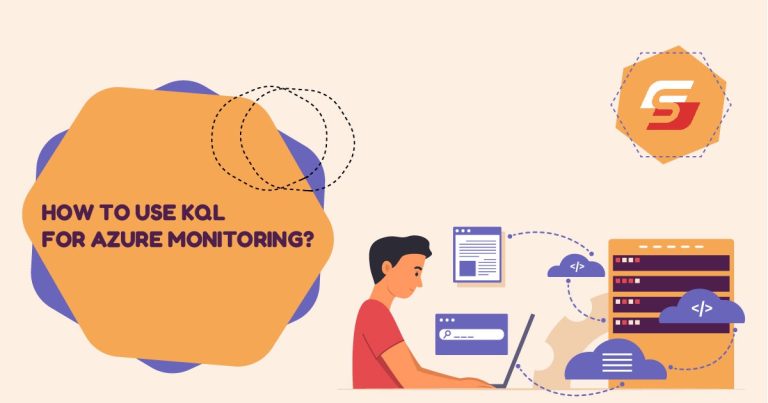Do you want to closely monitor the performance and health of the resources you manage on Microsoft Azure. You may gather and examine telemetry data from numerous Azure services using Azure’s robust tool, Azure Monitor. Azure Monitor’s data can be accessed using the potent query language known as Kusto Query Language, or KQL for short. It’s made to make it easier for you to effectively retrieve and analyze data from numerous sources. You may filter, aggregate, and visualize data with KQL to learn essential things about your Azure services’ functionality, security, and health.
In this blog post, we have explained the complete guide about How to use KQL for Azure monitoring.
Access Azure Monitor
To get started with KQL and Azure Monitoring, you need access to Azure Monitor. Here’s how to access it:
Log in to the Azure portal
Open your web browser, navigate to [portal.azure.com](https://portal.azure.com/), and log in with your Azure account.
Navigate to Azure Monitor
Use the search bar or the “All services” option to find and select “Azure Monitor.”
Select a Data Source
Azure Monitor collects data from various sources, including metrics, logs, and traces. Depending on what you want to monitor, select the appropriate data source:
Metrics: Metrics provide numerical data that describes the performance of Azure resources. For example, CPU usage, memory utilization, or network traffic.
Logs: Logs contain detailed information and can be used for troubleshooting, auditing, and tracking changes. Azure Monitor stores logs in Log Analytics workspaces.
Start Writing Your KQL Query

After choosing a data source, you can now create your first KQL query. Let’s begin with a straightforward example involving metrics data. Here’s a basic KQL query to achieve that:
- Specifies the data source (performance metrics).
- Filters the data to include only CPU usage metrics for the “_Total” instance.
- Aggregates the data by calculating the average CPU usage over 1-hour intervals.
- Selects and displays the relevant columns.
Visualize Your Data
Once you have your KQL query, you can visualize the results using built-in tools like Azure Monitor’s Metrics Explorer or Log Analytics charts and dashboards. This step helps you understand the data better and identify trends or anomalies.
Refine and Learn More
KQL is a versatile language, and you can create more complex queries to dive deeper into your Azure resources’ telemetry data. To become proficient, consider exploring online tutorials, and documentation, and practicing with sample queries.
Benefits of Kusto Query Language
Kusto Query Language (KQL), also known as Azure Data Explorer Query Language, offers several benefits that make it a powerful tool for data analysis and querying in various contexts. Here are some of the key benefits of KQL:
Designed for Big Data
KQL is designed explicitly for querying large volumes of data quickly and efficiently. It can handle massive datasets, making it suitable for analyzing telemetry data, logs, and other types of big data. KQL’s performance optimization features, such as indexing and caching, help execute queries faster. This is crucial when dealing with real-time or near-real-time data analysis.
Read Also: How to Login Ncedcloud-A Comprehensive Guideline
Ease of Use
Learning KQL is not too difficult, especially for people with an SQL background. A variety of users due to its simple and straightforward syntax utlize it. Filtering, aggregating, sorting, and merging data from many sources are among the querying options supported by KQL. It also provides powerful functions for data manipulation and transformation.
Time-Series Analysis

KQL excels at time-series data analysis. It helps you to easily aggregate and visualize data over time intervals, making it ideal for monitoring, trend analysis, and anomaly detection. It is tightly integrated with Azure services, particularly Azure Monitor and Azure Data Explorer. This integration allows you to seamlessly query and analyze data collected from various Azure resources.
Extensive Ecosystem
KQL has a growing ecosystem of tools and resources. You can use it with Azure Monitor, Azure Log Analytics, and other services, making it a versatile choice for various data analytics scenarios. KQL has an active community of users and developers who share their knowledge, best practices, and query samples. This community support can be invaluable when learning and working with the language.
Real-Time Analysis and Scalability
KQL is well-suited for real-time data analysis and streaming data scenarios. It allows you to analyze and act upon data as it is ingested, enabling immediate insights and actions. KQL can scale horizontally to handle increasing data loads without significant performance degradation. This scalability is essential for applications that require handling large amounts of data.
Security and Cost Efficiency
When working with huge datasets, KQL’s efficiency in querying and aggregating data can result in cost savings through lower computation and storage expenses. Security was considered when creating KQL. In order to guarantee that users only have access to the data they are authorized to query, it provides role-based access control (RBAC).
Conclusion
Kusto Query Language (KQL) is a valuable tool for Azure monitoring and data analysis. With this complete guide, you’ve taken your first steps in using KQL to gather insights into your Azure resources’ performance and health. As you gain experience, you’ll unlock even more powerful ways to leverage KQL for Azure monitoring. Kusto Query Language (KQL) offers a robust set of features and benefits that make it a valuable tool for data analysis and querying, particularly in the context of big data, time-series analysis, and Azure ecosystem integration. Whether you’re a data analyst, developer, or IT professional, KQL can help you efficiently extract insights from your data.


